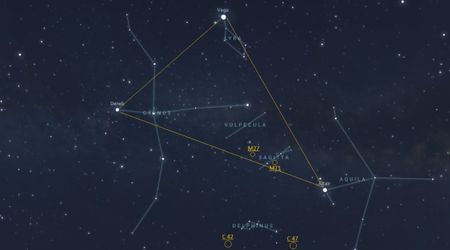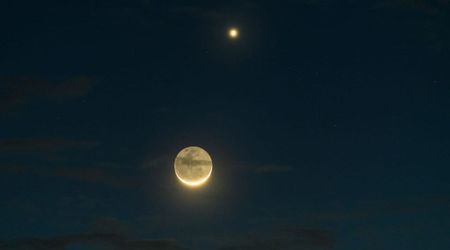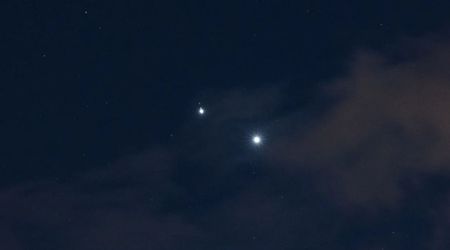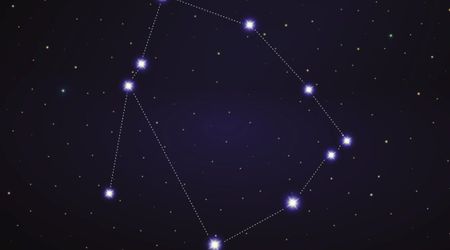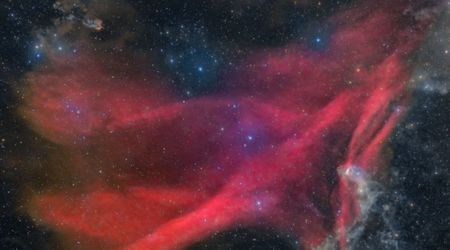Constellation Aquarius

A constellation of the zodiac, through which the Sun passes from mid-February to mid-March. It is an ancient constellation, known under various names over the ages.
In most myths, Aquarius is identified with Ganymede, cup-bearer to the gods. It is visible at latitudes between +65° and -90°, and best visible during the month of October.
Abbreviation: Aqr Genitive: Aquarii English name: Water bearer
Notable Stars in Aquarius
Alpha Aquarii (Sadalmelik) – A giant star with a diameter perhaps 100 times that of the Sun. It is located 760 light years from Earth and shines at magnitude 2.95.
Beta Aquarii (Sadalsund) – The brightest star of the constellation, shining at magnitude 2.9. Its computed distance is about 600 light-years from Earth.
Gamma Aquarii (Sadachbia) – A spectroscopic binary with a period of 58.1 days. It is located 158 light years from Earth and shines at magnitude 3.8. These figures lead to an actual luminosity of about 25 suns.
Maybe you noticed that the three stars described above share similar names. Their Arabic names translate into “The luck of the king”, “The luck of lucks”, and “The lucky star of hidden things”. The origin of the names is quite lost to history, but the next time you wish on a star choose one of these three. You might have a better chance for your wish to come true…
Zeta Aquarii – Zeta is the central star of the Y-shaped asterism that makes up the water jar of Aquarius. It is a close pair of 4th-magnitude stars 1.7 arcseconds apart.
R Aquarii – An interesting variable star that reaches the 6th magnitude at maximum and has a period of little over a year. R Aquarii is a symbiotic star system, an interacting pair consisting of a variable red giant and a white dwarf companion.
Notable Deep Sky Objects in Aquarius
M2 – A bright globular cluster visible with the naked eye in a dark sky. Through binoculars or a small telescope, it appears as a small hazy patch with a diameter of 7 arcminutes.
M72 – A faint globular cluster located in the western part of the constellation. It is unimpressive in small telescopes, appearing as a pale nebulous patch of light.
M73 – This object is a small asterism composed of four stars with magnitudes between 10.5 and 12. Seen with a small telescope M73 looks like a tiny nebulosity, and this is probably why Messier included this object in his catalog.
NGC 7009 (The Saturn Nebula) – One of the brightest planetary nebulae in the sky, first observed by Sir William Herschel in 1782. It was named the Saturn Nebula because when observed with larger telescopes its shape resembles that of the planet Saturn.
To find NGC 7009, center the 5th-magnitude star Nu Aquarii in your finder scope and then move one degree to the west. At low powers, the nebula is almost starlike, but going to higher powers reveals a bright greenish disk with no other evident details.
NGC 7293 (The Helix Nebula) – The closest of all planetary nebulae, lying at a distance of 400 light-years from Earth. To find the nebula, start from Fomalhaut (Alpha Piscis Austrinus) and move your telescope 11 degrees northwest to 5th-magnitude 47 Aquarii. From this star slide two degrees east to Upsilon Aquarii, and you’re almost there. The Helix is just one degree west of this star.
Small scopes show NGC 7293 as a circular patch of faint light, but a 6-inch scope reveals that the center is dark and contains a 13th-magnitude star. The nebula’s diameter is 16 arcminutes, so when observing use a wide field eyepiece and low magnification.
Meteor Showers
The Eta Aquarids shower is active between April 21 and May 12, from a radiant located in the north-central portion of the constellation. Maximum activity occurs on May 5th, when the shower produces about 20 meteors per hour for observers in the northern hemisphere and 50 for observers in the southern hemisphere.
The shower of the Delta Aquarids is divided into two sub-showers separated by 15 degrees of declination.
The southern Delta Aquarids are active between July 14 and August 18, with a maximum of 20 meteors per hour on July 29. The duration of the northern Delta Aquarids shower covers the period of July 16 to September 10. The maximum occurs on August 13th when ten meteors per hour can be seen in a dark sky, away from city lights.
The Iota Aquarids also show two distinct showers. The southern Iota Aquarids occur from July 1 to September 18, and the August 6th maximum produces about eight meteors per hour. The northern Iota Aquarids have a duration from August 11 to September 10, with maximum activity on August 25 when the shower produces five to ten meteors per hour.
Discover More Constellations ?
This page is part of our collection of constellation articles. If you enjoyed the read, then you'll love the following articles.

Meet Aries, The Ram Constellation

Meet Aquila, The Eagle Constellation

Meet Antlia, The Air Pump Constellation

